Higher education stakeholders, who for this paper are defined as being the potential/current students, staff and management, continue to become more conscious of the principles of sustainability. This higher level of understanding promotes the needs to assess existing literature in relation to the actual needs of the stakeholders in order to identify existing features, trends and needs so that there is continual improvement in the field.
This paper shows that sustainability is currently a socially desirable trait but other factors, such as becoming more competitive in the job market, supersede it in importance to stakeholders. It also shows that there is a general need for a standardized method for assessing institutions, with AASHE’s STARS system being the most used system.
1. Introduction
Globally, societies are subject to an intertwined future that immerses people into the realities of climate change, social inequalities and fragile economic systems. There is a growing need for sustainable development, which is “development that meets the needs of the present without compromising the ability of future generations to meet their own needs” (UN, 1987).
Since the 2002 Johannesburg Summit, the special role of our education systems in facilitating, envisioning, and leading change towards sustainability has been the focus of renewed attention (Ryan et. al., 2010). International leaders have declared education as a motor for change, with the United Nations General Assembly implementing the Decade of Education for Sustainable Development from 2005-2014 (UNESCO 2011).
There is also a growing public expectation that universities should start focusing on delivering sustainability. Students in particular are starting to place an emphasis on sustainability. This emphasis is highlighted by the demands of new students entering the university. Students not only placed high value on many aspects of sustainability, but also expressed that sustainability concerns are a significant factor in students’ university choices (Bone and Agombar 2011).
Indeed this view directly corresponds with industries uptake of the notion of sustainability in higher education. An overview of the top 100 Universities as listed on the Times Higher Education World University Rankings (TSL Education Ltd., 2012) reveals that 100% of the universities have marketed some sort of sustainability initiative. These included, but were not limited to, fully functional research centers, sustainability programs, research initiatives, student involvement or campus wide plans. This comprehensive uptake demonstrates the significance of sustainability and suggests continued interest in the future.
Sustainability in higher education often varies in scope and magnitude and covers a wide gamma of initiatives. Initiatives range from something as simple as offering an elective course to deep social integration between the community and the student population. Various assessment methods assess the level of sustainability differently; however there is some consensus among assessment methodologies that measure sustainability. A review of the GreenerU (2010) shows that most methodologies have some shared characteristics, such as focusing on academics (education and research), real estate (buildings and amenities), control of essential flows (e.g. energy, water, food, materials and their wastes), management and operation, and transportation.
Institutions are starting to incorporate these sustainability initiatives in their values, principles and marketing. There are even efforts to standardize the measurement of sustainability within institutions. An example of this ‘sustainability ranking’ for universities is the “Princeton’s Guide to 311 Green Colleges” (The Princeton Review 2011). Organizations such as The Association for the Advancement of Sustainability in Higher Education (AASHE) have skyrocketed in acceptance (GreenerU, 2010 and Dole et. al., 2011), providing the Sustainability Tracking and Assessment Rating System (STARS) assessment tool for sustainability within higher education. The self-reporting assessment method, similar to other methods available, offers a great tool for institutions to develop sustainable practices but falls short of providing a concrete system for comparing institutions.
While this brief introduction does not aim to cover the entire gamma of research in the field, it does seek to create a strong argument that sustainable practices are becoming part of the standard requirements of higher education institutions. The acceptance of institutions to initiate sustainability-related activities as well as the desire of both the public and policy makers to actively promote sustainability predicts that there will be continued interest in this field going forward.
What this also supports is that there is need for a more uniformed approach to dealing with sustainability within the education industry. A lot of efforts seem to be reproduced which may inhibit research development and allows for a disconnect from the realities of the field. For example, there are a variety of assessment methods currently available to measure institutions sustainability. All of these systems ultimately serve the same goals, but they do not necessarily serve the goals of an interested student that is looking to compare two institutions. Furthermore, these assessment methods generally do not place any emphasis on key economic factors that are the primary motivation for students.
By conducting a survey, this paper looks to identify these features, trends, and needs so as to start a more meaningful discussion towards convergence of research initiatives in order to make more specific contributions towards this growing field. This overarching survey looks to identify key features through the analysis of empirical data that will help shape future research and progress in the field.
2. Methodology
2.1 Survey Outline
A survey was created to determine the validity of the existing common practices in higher education in relation to sustainability and identify existing lapses and future trends. The survey was created with the input from various international experts in sustainability.
This survey also was created for a defined demographic within the higher education industry. The survey was created for direct stakeholders in higher education, which for this paper is defined as potential or current students, staff and management.
It is important to note that this survey looks to approach educators in a more holistic view. Often within higher education, learning can happen through other avenues than just faculty. Thusly, educators are included as educational staff and not limited to just faculty.
This paper is limited to specific areas of interest. These areas were limited to: Student Needs, Staff and Management Needs, Assessment Methods, and Economic Factors. These areas of interest, as a whole, look to identify the importance of sustainability to stakeholders, determine if it is conceptually and practically applicable, and see what stakeholders feel is the future of the field. These are individually overviewed as follows:
Students Needs
The survey aims to validate Bone and Agombar’s (2011) results and expand on the needs of students. It attempts to quantify the perception of sustainability within the student demographic by exploring students understanding of the term sustainability.
It also attempts to understand how students make decisions with specific emphasis on motivating factors and methods used to research sustainability.
Finally, it looks to make a distinction between the conceptual and practical importance of sustainability.
Staff and Management Needs
The survey directly addresses the employee demographic that is repeatedly identified as a driving force that is needed in order to promote and support sustainability within an institution. As with the students’ needs, it attempts to quantify the perception of sustainability while also attempting to understand the distinction between the conceptual and practical importance of sustainability.
This survey focuses on the composition of the staff beyond just faculty. It addresses educational staff (which includes faculty), general staff and staff that are sustainability focused.
Assessment Methods
There is a variety of assessment and rating systems that are available to assess sustainability. The survey aims to identify which one is most used and which one the stakeholders believe is best suited for assessing sustainability.
Economic Factors
Although economics is one of the main categories of the triple bottom line, it is hardly used in context to the stakeholders, and specifically with regards to students. The survey looks to understand if there is economic motivation for students to undertake their degrees and if they consider post-graduation metrics of economics to be part of an institutions measure of sustainability.
2.2 Survey Questions and Data Collection
The actual survey format and questions are found within the appendix. The process of creating the survey was based on various key elements identified within higher education institutions assessment of sustainability. It was created to collect data on stakeholder perception and looks to provide empirical evidence for future studies. The survey was overarching and experimental and looked to serve the purpose of this paper and future papers. It could be broken into three parts: assessment methods and performance, economic factors, STARS performance and general stakeholder preferences.
The survey was created using Google forms and was promoted utilizing various channels of communication. It was heavily promoted at the AASHE 2012 conference and internationally through key contacts within universities in North America, Europe, Asia, Africa and Australia. Social media tools as Facebook, Google and similar sites were also used to gather information.
Due to this methodology, there is the potential for promoting bias in the results. The two primary sources of bias stem from the promotion of the survey at the AASHE conference and promotion of the survey through digital media that trend towards sustainability efforts in higher education institutions. Although some of this bias cannot be measured, some steps were taken to isolate potential bias.
Seeing as this survey was heavily promoted at the AASHE conference, it can be inferred that this would be a major source of bias as participants may be more aware of sustainability in higher education. To isolate this bias, two identical surveys were created in Google forms and AASHE conference participant were given a unique hyperlink to one of the surveys. There were a total of 56 responses that were registered from October 14-31 of 2012. These results are presented in the discussion when applicable to highlight any divergence from the overall results.
A major emailing campaign also was conducted by searching for “university sustainability” in Google and emailing the relevant parties which also allows for biased responses. Although various emailing campaigns were also general in nature to universities throughout the world, there is no way to pinpoint responses due to the anonymous online format of the survey. Other steps, namely the creation of a unique survey for each emailing campaign, are recommended for future research.
3. Survey Results
To facilitate the effectiveness of this paper, the results of the survey have been broken down by the aforementioned specific areas. Some general highlights of the survey are as follow:
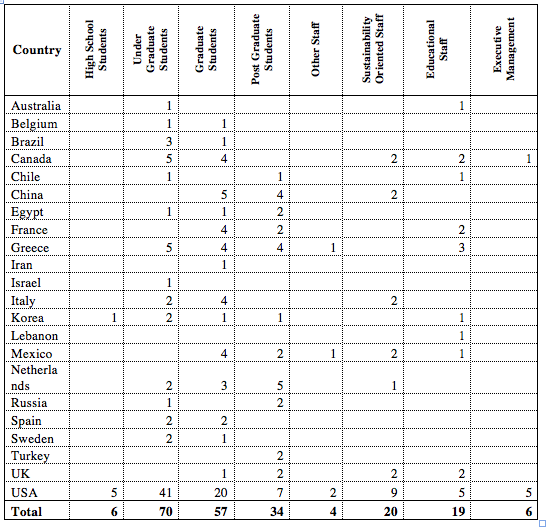
Table 1. Classification of respondents by country
|
There were a total of 203 respondents, which were composed of 60% Male and 40% female participants. A total of twenty-two countries were represented and students made up 84% of the responses. From the 203 responses, there were a total of 216 classifications. This stems from the fact that students are also employed at Universities. A total of thirteen students identified themselves as concurrent employees in the areas of sustainability staff, educational staff and executive management.
It is important to note the significance in the number of respondents. Although 56 respondents were from the AASHE conference, there was also significant participation from a wide variety of stakeholders outside of AASHE. There are not enough respondents to make any definitive conclusions about preferences and behaviors of higher institution stakeholder internationally. There is, however, a substantial amount of respondents that provide adequate data for this level of empirical research.
3.1 Student Needs
In order to address student needs, several questions were asked. The first question was meant to create a baseline for understanding what the general perception of the term sustainability was to the students. Students were asked to choose which terms were best associated with sustainability from a list of terms. The results showed that students are associating a wide variety of terms with sustainability which is an affirmation that there is a more fundamental understanding of the depth and ambiguity of the term. The results are shown in Figure 3.
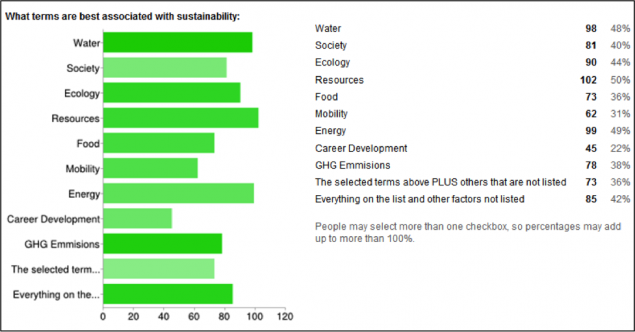
Figure 1. Terms that respondents associated with sustainability
|
This understanding was validated by a follow-up question which asked participants to define sustainability. This question did not seek to define sustainability, but rather sought to discover how many participants misunderstood sustainability as being solely an ecological term. The results showed that only 3% of participants related sustainability as being solely an ecological term. It is important to note that there was no noticeable bias that stemmed from AASHE participants.
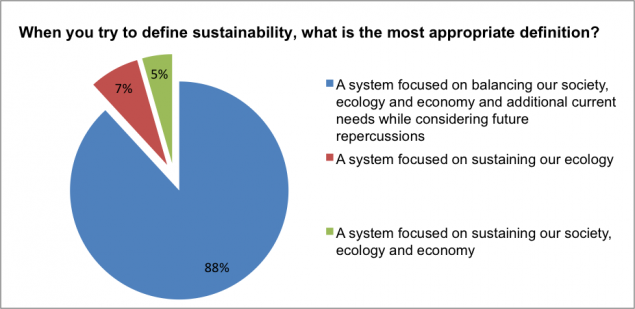
Figure 2. Defining sustainability
|
Overall, the responses to these questions help establish that students are fairly proficient with the term sustainability in the broadest context. The responses suggest that the complexity of the term, as well as the ambiguity, is understood by the students. There is no noticeable bias from AASHE participants; however there is a certain level of bias that may stem from the sustainability inclined participants targeted in the digital promotion.
The survey also validated Bone and Agombar’s (2011) conclusion that sustainability is an important part of the student decision making process. When asked if the sustainability of a higher education institution was import in their selection, 90% responded that it did. This helps validate that Bone and Agombar’s conclusion is applicable in a more international context rather than just in the United Kingdom.
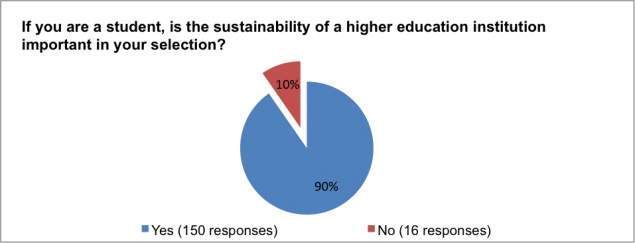
Figure 3. Importance of sustainability in students' decision making
|
A significant finding of this study was the delineation between the concept of sustainability and the practicality of sustainability. Although 90% of students said that sustainability was an important part of their decision making, only 59% said that they would not attend an institution if it was unsustainable. It is interesting to note that AASHE participants were also close to this distribution, seeing as 86% said sustainability was important while only 64% would act on this belief. This deviation is important as it suggests that sustainability within higher education currently is a socially desirable trait that students will not necessarily act on.
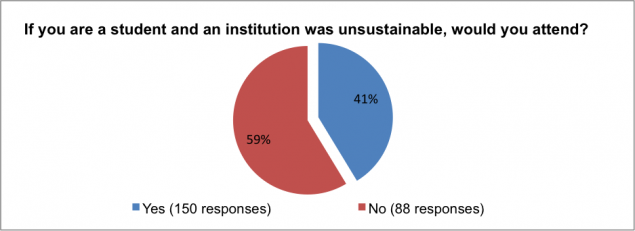
Figure 4. Students attending unsustainable institutions
|
The survey also identified methods with which students research the sustainability of higher education institutions. The survey suggests that students use various methods for determining what they believe is the sustainability of an institution. It is important to note that although an institution’s marketing may be used in part by students it is only used by 4% of the participants as their sole source of information in order to assess an institution.
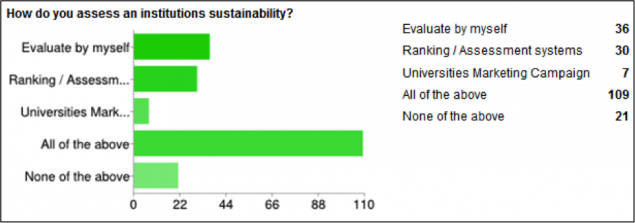
Figure 5. Assessment of higher education institutions
|
3.2 Staff and Management Needs
In order to assess the staff and management of an institution, it is important to understand the demographic of the participants that responded to this survey. Of the forty-nine respondents classified as employees, thirteen were also concurrently students. This composition is not necessarily representative of all institutions, however it does raise an important discussion point as to how much student workers influence the transmission of an institutions sustainability initiatives.
The delineation of the conceptual and practical aspects of sustainability is more prominently displayed in relation to employment in higher education. 87% of participants stated that sustainability was important in their job satisfaction, however only 35% would consider working somewhere else if their institution was unsustainable. This result is even more significant when analyzing participants that are solely employees compared to employees that are also students. 88% of the participants that were exclusively employees responded that sustainability was important for their job satisfaction while only 12% would consider working somewhere else. On the contrary, 85% of student employees responded that sustainability was important for their job satisfaction while 46% would actively search for something else if the institution was not sustainable. It is important to note that the AASHE participants also fell very close to this distribution.
This polarization brings up a variety of discussion points that warrant further research in establishing causality for this phenomenon. Initially, the difference between the students and the employee suggest the security of money is more important than sustainability for employees. However this may also suggest that educational initiatives over the last decade have created a sustainability generation gap that is more representative of modern society. It may also suggest other factors, such as the limited uptake of sustainable practices within higher education resulting in few choices for job relocation.
3.3 Assessment Methods
Participants were presented with a variety of the most popular rating and assessment systems that are available to determine the sustainability of a higher education institution. 26% of participants did not know of any sort of sustainability assessment systems. These participants were mainly students and are statistically significant as it suggests that the systems, in general, are not known by a sizeable section of their target market. This could be because the area of institutional assessment is over-saturated considering that there are over 20 assessment methods. The abundance of assessment methods may prohibit integration with institutions marketing campaigns and support incoherent messaging and branding. This assertion is supported by Hemsley and Oplatka (2006) studies that found higher education marketing “incoherent” as well as Selby et. al. (2009) suggestion that “rigorous institutional engagement with marketing sustainability credentials can have a significant impact on the quality and depth of sustainability performance by helping spread, enrich and diversify the institutional sustainability culture.” It is significant to note that the AASHE participant provided a very unique response. Of the participants responding, a total of 32% did not know of any sustainability assessment system. This could be for a variety of reasons; however it presents a case that the AASHE participants represent a wide variety of stakeholders.
Of the participants familiar with one or more of the systems, AASHE’s STARS was the best known with 88% of participants saying they were familiar with the system, followed closely by the Princeton Review’s Green Rating with 67%. The important point to note is that the third most popular system, the College Sustainability Report Card at 62%, has recently been suspended. Also important is the fact that from the AASHE participants, STARS was the best known system, however only 61% knew of the STARS system suggesting that participant were potentially not affiliated with AASHE and not as biased, in terms of assessment systems, as would be initially expected.
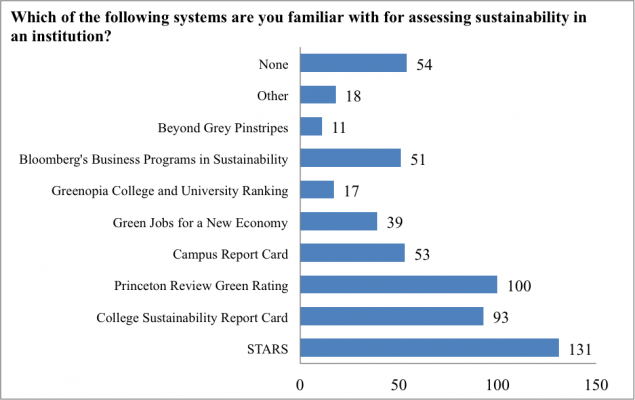
Figure 6. Familiarity with assessment methods
|
Of the 149 respondents familiar with the assessment systems, 60% thought that the STARS was the best method for assessing an institutions sustainability. There was some bias noticed from AASHE respondents as 71% thought STARS was the best system.
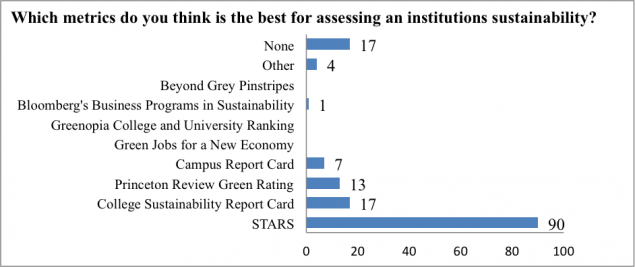
Figure 7. Best metric for measuring an institutions sustainability
|
Regardless of their familiarity with assessment systems, an overwhelming 192 of the respondents, or 95%, believed that institutions needed to be uniformly rated on sustainability. This strong percentage clearly shows that stakeholders need to have a more standardized system of assessment.
3.4 Economic Factors
Economic factors proved to be a major motivation for students to pursue a degree in higher education. Of the students pursing higher education, 71% said they were doing it for personal accomplishment and future employability, 22% said they were doing exclusively for future employability, while only 7% responded to doing it either exclusively for personal accomplishment or for some other reason. This finding shows that the economic factors surrounding the attainment of a degree is a significant factor for all students pursuing higher education. There are some noticeable differences with the AASHE participants, namely that 77% responded that they were pursuing higher education for personal accomplishment and future employability while none of the participants responded to doing it solely for personal accomplishment.
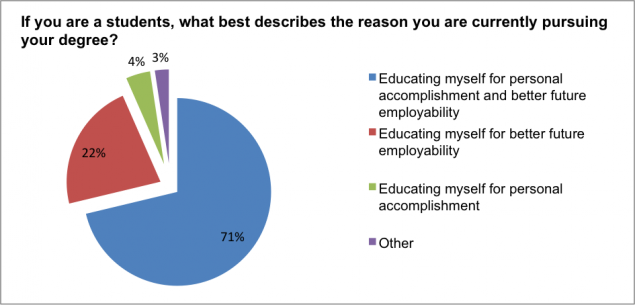
Figure 8. Motivation for degree
|
This significance of economic factors in sustainability is further highlighted by the importance that all participants placed on economic factors as a metric for sustainability. An overwhelming 186 of respondents, or 92%, agreed that employability after completion of a degree was a parameter for measuring institutions sustainability. This belief is also closely upheld by the AASHE participants.
In fact, 162 of respondents, or 80%, went as far as agreeing that an institutions ability to make you more competitive in the job market is more important than sustainability. Of the remaining 20%, it was repeatedly mentioned that the two factors are intertwined and thus inseparable. These results are also in line with the responses from AASHE participants.
4. Conclusions and Discussions
4.1 Discussion of the Method Used
This survey has collected a variety of useful empirical data, however there are some critical discussion topics that should be considered when using these results and conducting further research.
The first concern is relative to the bias of the survey. A major marketing campaign for the survey was conducted during and AASHE conference, which caters to sustainability aware stakeholders. A major emailing campaign also was conducted by searching for “university sustainability” in Google and emailing the relevant parties which also allows for biased responses. Emailing campaigns were also general in nature to universities throughout the world, however due to the online format and anonymity of respondents it is not possible to pinpoint and measure any bias. Having isolated the AASHE participants in the presentation of the results, it is noted that there is indeed a level of bias in some responses. However useful this may be, it is still unable to eliminate the bias that may stem from sustainability inclined individuals that were reached through digital media. As such, it is suggested that the data should be considered empirical and should best represent sustainability aware stakeholders in higher education rather than all stakeholders within higher education. In order to ascertain more representative results, it is suggested that a much larger sample that encompasses the entire gamma of stakeholders in higher education is conducted.
The promotion of the survey at the AASHE conference also creates the potential for bias towards the preference of STARS as the ideal assessment tool. Although AASHE respondents, as a whole, were less knowledgeable of assessment systems they did show a strong preference towards the STARS system. Although this is a concern, the results would have been the same without the AASHE participants. Furthermore, the results are also supported by other literature that suggests STARS is one of the most popular systems which validates the relevance of the empirical data collected.
Another concern is with the unsecure format of the survey. The survey was conducted online via Google forms and thus could not eliminate respondents from potentially duplicating responses. It also could not geographically locate respondents which raises uncertainty regarding the demographics of the respondents. For example, how do you categorize a foreign national? Is it based on the country in which they are studying or the country in which they are from? These uncertainties limit the usefulness of the survey and raise questions as to how accurately it represents all the countries declared in the survey. The questions should have been rephrased so as to gather data both on the country of origin and the country of study.
Other concerns lie within the survey itself. This survey was conducted in support of research that had already identified key research points and was broad in scope. This paper deals with specific areas of the survey without taking into account the other questions which may have influenced or affected the data. In an ideal situation, a representative group of stakeholders would have been identified and surveyed progressively as research advanced in order to provide some definitive results.
Due to these concerns, uncertainties and the limited amount of responses this data and resulting conclusions should be considered weak evidence and used in conjuncture with other research to provide meaningful results. Deviation from previously published work and/or new results coming from this data should be used for empirical research and as grounds for further, more definitive, research.
4.2 Interpretation of Survey Results
For the largest part, the survey presented in this paper has helped identify features, trends and needs in higher education in relation to sustainability. The primary stakeholders of institutions of higher education, identified in this paper as prospective/current students, staff and management, have shown a fairly wide understanding of the term sustainability. Only 3% of participants identified sustainability as being a solely ecological term, with the rest of the respondents acknowledging a much broader and varied definition of sustainability. Although no concrete results can be formulated, the results support that there may be a measurable effect from some of these global initiatives at raising sustainability awareness, such as the UN’s Decade of Education for Sustainable Development, although again this interpretation is subject to the bias found within survey.
The importance of institutions sustainability in students decision making identified in other literature was validated in this survey as a conceptual notion. However, there was a significant statistical difference between whether a student would actually act on the lack of sustainability within an institution, with 90% of students saying that sustainability was an important part of their decision making yet only 59% said that they would not attend an institution if it was unsustainable. This difference suggests that sustainability is a socially desirable idea but there are other factors that supersede in motivating students.
The same statistical divergence was noted in employability. 87% of participants stated that sustainability was important in their job satisfaction, however only 35% would consider working somewhere else if their institution was unsustainable. This result is even more significant when analyzing participants that are solely employees compared to employees that are also students. 88% of the participants that were exclusively employees responded that sustainability was important for their job satisfaction while only 12%would consider working somewhere else. On the contrary, 85% of student employees responded that sustainability was important for their job satisfaction while 46% would actively search for something else if the institution was not sustainable.
This polarization brings up a variety of possible discussion points that warranty further research in establishing causality for this divergence. However, this survey does suggest a possible correlation between the superseding importance of economic factors in relation to sustainability. 80% of participants placed more importance on the institution’s ability to make you more competitive in the job market rather than the sustainability of the institution. Further studies are suggested in order to validate this potential correlation.
4.3 Recommendations
The survey supports unequivocally that stakeholders have two needs that are currently not being addressed. 95% of respondents agreed that there was a need for a uniform rating system of sustainability within institutions of higher education. Of those knowledgeable of the various methods of assessment currently available, AASHE’s STARS was the best known (88%) and also the most supported as being the ideal system (60%). The results suggest that STARS could be an ideal system for standardization if it is improved or augmented in order to address a broad range of stakeholders.
Another need that was identified was the lack of economic factors as measures of sustainability. 92% of participants agree that employability after graduation should be included in the measurement of institutions sustainability. This strong support for economic metrics to be included is sustainability assessment should be reviewed throughout the industry in order to initiate discussions as to how to properly combine the existing assessment methods in order to include economic metrics in relation to employability and job competitiveness.
Based on these results, if sustainability was to include the economic factors needed by students, sustainability would better address the needs of students and no longer be just a socially desirable trait. It also suggests that the STARS system could be used as a baseline to integrate these economic factors in order to better serve stakeholders.
As a concluding statement this survey has also displayed a general gap of practicality between stakeholders and the industry. Great progress has been made in a short period of time with academic research and collaboration in sustainability in higher education; however, there is evidence of glaring needs that are not being addressed. Methods for standardizing methodologies, centralizing knowledge and promoting industry-wide initiatives are needed in order to increase the effectiveness of sustainability in higher education.
4.4 Outlook
Based on the data collected, conclusions and other literature on the subject a series of research initiatives are recommended in order to provide more definitive results.
Further research on assessment methods needs to be conducted in order to validate the results of this paper. An analysis of the actual assessment methods, similar to others previously done, can help provide guidance on the most effective assessment methods and validate if STARS is really the best method.
Based on the data collected, stakeholders overwhelmingly support a standard rating system for sustainability in higher education. A review of the best methods, with an emphasis on STARS, should be conducted in order to see if it is feasible to have a uniformed rating system and what it may potentially look like.
Finally, further research should be conducted on the economic aspects of sustainability in relation to higher education. Currently there is very little discussion on the economic factors identified in this paper as measures of sustainability within higher education. It is also noticed that the economic factors identified are not uncommon within higher education. A review of systems that currently conduct these kinds of rankings, as well as relevant sustainability assessment system, needs to be conducted in order to identify synergies and collaborations that could better meet the needs of stakeholders.
References
ACUPCC (2009). Education for Climate Neutrality and Sustainability: Academic Guidance for ACUPCC Institutions.
Bone, E., & Agombar, J. (2011). First-year attitudes towards, and skills in, sustainable development. The Higher Education Academy.
Comm, C.J. and Mathaisel, D.F.X. (2003). Less is more: a framework for a sustainable university. International Journal of Sustainability in Higher Education. Vol. 4, 4, pp. 314-323.
Cortese, A. D. (2003). The critical role of higher education in creating a sustainable future, Planning for Higher Education, March-May, p. 15-22.
Datal-Clayton, B., & Bass, S. (2002). Sustainable development strategies (First Edition ed.). London: Earthscan Publications Ltd.
Dola, K. B., Saadatian, O., Tahir, O. M. (2011). Identifying Strengths and Weakness of Sustainable Higher Educational Assessment Approaches, International Journal of Business and Social Science, Vol 2, No. 3, 137-146.
Greener U (2010). Higher Ed Sustainability Ratings, Rankings & Reviews, A GreenerU Guide.
Hemsley-Brown, J., Oplatka, I. (2006). Universities in a competitive global marketplace: A systematic review of the literature on higher education marketing, International Journal of Public Sector Management, Vol 19, 316-338.
Jucker, R. (2002). “Sustainability? Never heard of it!” Some basics we shouldn’t ignore when engaging in education for sustainability. International Journal of Sustainability in Higher Education, 3 (1), pp. 8-18.
McIntosh, M., Gaalswyk, K., Keniry, L., & Eagan, D. (2008). Campus Environment 2008 – A National Report Card on Sustainability in Higher Education. National Wildlife Federation.
Miller, H. (2005). Creating a Culture of Sustainability: How Campuses Are Taking the Lead. Herman Miller.
Puukka, J. (2008). Mobilising higher education for sustainable development – lessons learnt from the OECD study. Proceedings of the 4th International Barcelona Conference on Higher Education, Vol. 7. Higher education for sustainable development.
Reid, A., & Petocz, P. (2006). University lecturers’ understanding of sustainability. Higher Education, pp. 105-123.
Ryan, A., Tilbury, D., Corcoran, P. B., Abe, O; Nomura, K (2010). Sustainability in higher education in the Asia-Pacific: developments, challenges, and prospects, International Journal of Sustainability in Higher Education, pg. 106-119.
Selby, D., Jones, P., Kagawa, F. (2009) Sustainability Promotion and Branding: Messaging Challenges and Possibilities for Higher Education Institutions.
Sherman, D. (2008). Sustainability: What’s the Big Idea? A Strategy for Transforming the Higher Education Curriculum. Sustainability, 1 (3), pp. 188-195.
Shriberg, M. (2002). Institutional assessment tools for sustainability in higher education: strengths, weaknesses, and implications for practice and theory. Higher Education Policy, 15(2), 153-167.
Stephens, J.C. and Graham, A.C. (2008). Exploring Change Towards Sustainability in Universities by Adapting Transition Management. Barcelona : Environmental Management of Sustainable Universities (EMSU) 2008 Conference.
The Princeton Review. (2011). The Princeton Review’s Guide to 311 Green Colleges (2011 Edition ed.), The Princeton Review.
TSL Education Ltd. (2012). World University Rankings 2012-2013
UN (United Nations) (1987). Our Common Future, Oxford University Press, Oxford.
UNESCO (2011). Education for Sustainable Development.
UNESCO. (2005). Guidelines and Recommendations for Reorienting Teacher Education to Address Sustainability. Education for Sustainable Development in Action, Technical Paper 2.
ABOUT THE AUTHORS
Antonios Maragakis is a PhD student at the Delft University of Technology, the Netherlands. His research focuses on sustainable assessment systems in higher education. Antonios has a wide spectrum of international experience in senior management positions and has also been lecturing at both an undergraduate and graduate level in various business and technical areas. His expertise is in sustainable business systems and methods which he implements with both practical and theoretical knowledge.
Andy van den Dobbelsteen is a full professor of Climate Design & Sustainability, at the Faculty of Architecture of the Delft University of Technology, the Netherlands. At TU Delft he is the coordinator of the Green Building Innovation research program and Delft Energy Initiative theme leader for the built environment. Andy lectures and leads research projects in various areas of sustainability in the built environment, most notably on sustainable energy systems for neighborhoods, cities and regions. He is also an expert author to the national website on sustainable building (www.duurzaamgebouwd.nl) and chaired various national and international conferences, among which the award-winning SASBE2009.
|